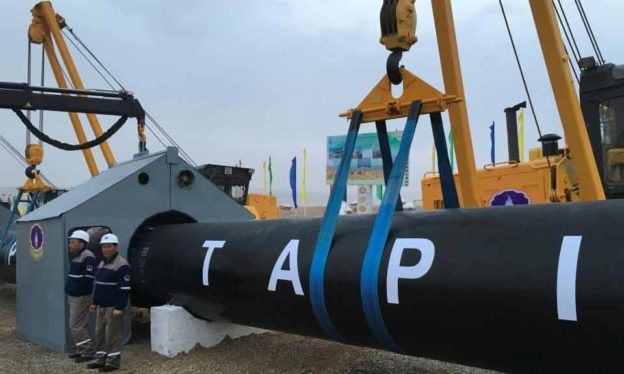The amount of electricity produced fluctuates depending on the time of day, moon phase, season, and uncontrollable variables like the weather. Energy derived from solar, tidal, and wind source naturally varies on time scales ranging from minutes to weeks or longer. Therefore, renewable poses unique difficulties for electric utilities in the absence of storage. While connecting numerous independent wind sources helps lessen overall unpredictability, solar power is invariably unavailable at night and tidal power fluctuates with the moon, resulting in four times per day of slack tides. Coal, biomass, natural gas, and nuclear power generation that relies on energy stored in fuels must be ramped up and down in an electrical grid without energy storage to keep up with the rise and fall of electrical production from intermittent sources (see load following power plant). Nuclear and coal power facilities have a very long time to adjust to load, whereas hydroelectric and natural gas power plants may be quickly scaled up or down to follow the wind. Demand management, grid interconnections, or pricey pumped storage are therefore more frequently used by utilities with lower levels of natural gas or hydroelectric power.
The ability to store energy at peak output, release it during peak demand, and use it when production unexpectedly drops has made commercially feasible projects possible. This gives time for slower-responding resources to be brought online. Peaking power plants and demand response, which shifts load to other times, are two alternatives to grid storage. The unpredictability of wind energy has had regional effects that have increased the requirement for interactive demand response, where the utility interacts with the demand. Historically, only large industrial customers were involved, but this practice may now be used for entire grids.
For grid-scale applications, a variety of energy storage technologies (such as pumped-storage hydroelectricity, electric batteries, flow batteries, flywheel energy storage, and supercapacitors) are suitable, although they have different properties. For instance, because of their large capacities and power capabilities, pumped-hydro stations are suitable for applications involving bulk load management. However, there aren’t many ideal places, and when dealing with concerns with localized power quality, their value wanes. Flywheels and capacitors, on the other hand, are the best at preserving power quality but do not have enough storage space to be used in bigger applications. The applicability of the storage is naturally constrained by these restrictions. In the early days of direct current electric power, battery storage was utilized. Isolated lighting plants powered by internal combustion engines or wind turbines provided lights and power to tiny motors in areas where AC grid electricity was not easily accessible. When the wind was quiet or when the engine wasn’t running, the load could be powered by the battery system. Lamps were lit, and an engine was started to replenish a bank of lead-acid batteries that were housed in glass jars. For more recent lithium-ion devices, battery storage technology is typically between 80% and more than 90% efficient.
Power distribution networks have been stabilized using battery systems coupled with massive solid-state converters. A few grid batteries are situated near renewable energy sources, either to smooth the erratic power from wind or solar production or to shift the power output to other times of the day when the renewable source cannot directly supply power.
Technologies used in the automotive industry rely on solid electrodes, which have a high energy density but expensive manufacturing processes. Since they don’t require any processing, liquid electrodes are a less expensive and dense option.
Tag Archives: Pakistan
Zargham Eshaq Khan Assumes Charge of Acting MD NESPAK

Muhammad Zargham Eshaq Khan, Vice President of National Engineering Services Pakistan Pvt. Limited (NESPAK), has assumed the charge of Acting Managing Director of NESPAK, effective May 31, 2023. This appointment follows the approval of the Board of Directors of NESPAK. Zargham Eshaq Khan will be responsible for overseeing the company’s affairs.
Zargham Eshaq Khan is a highly regarded professional engineer with an impressive academic and professional background. He holds a B.Sc. in Electrical Engineering and an MSc in Optics and Illumination Engineering from UET Lahore. Since joining NESPAK in 1993, he has served in various key positions, including his most recent role as VP/Head of the New Ventures Division.
With over 30 years of experience in the field of engineering, Zargham Eshaq Khan has developed expertise in policy and finance management in Pakistan’s power sector. He has been involved in significant projects such as the development of the China-Pakistan Economic Corridor (CPEC) framework agreement and the settlement of international arbitration disputes related to the power sector in Pakistan. He has also played a crucial role in the implementation of power sector reform programs under the Asian Development Bank (ADB) and the World Bank. Furthermore, he has represented Pakistan in energy dialogues with the United States, as well as in SAARC, Pakistan-Russia, and Pakistan-Turkey energy forums.
Zargham Eshaq Khan has served on the Board of Directors of various power sector entities, including power distribution companies (LESCO, GEPCO, PESCO, and MEPCO), power generation companies (GENCO III), Pakistan Electric Power Company (PEPCO), Power Holding Private Ltd (PHPL), and Central Power Purchasing Agency (CPPA-G). During his tenure as MD of PEPCO, he was instrumental in managing the power sector and implementing a devolution plan for power sector reform. As the CEO of PHPL, he successfully completed Pakistan’s largest debt swap Sukuks, totaling Rs 400 billion, and managed power-holding debt and loans amounting to Rs 600 billion with various financial institutions and banks. Mr. Zargham is also credited with introducing Islamic financing in the power sector.
For approximately 10 years, Zargham Eshaq Khan served as Joint Secretary in the Ministry of Energy Power Division, where he held additional roles as Managing Director and Chief Executive Officer of power sector entities.
Throughout his illustrious career, Zargham Eshaq Khan has maintained an impeccable reputation for his integrity and efficiency. He is known for his adherence to rules and regulations. As the head of NESPAK, a premier consultancy organization in Pakistan, he is poised to contribute significantly to its growth and the engineering fraternity through his exceptional management skills and extensive experience.
World Environment Day and Pakistan

World Environment Day is celebrated annually on June 5th and serves as a global platform to raise awareness and take action on pressing environmental issues. Here are some key points about World Environment Day:
Purpose: World Environment Day, established by the United Nations in 1972, aims to encourage global awareness and action for the protection of our environment. It promotes engagement from individuals, communities, organizations, and governments to address environmental challenges.
Theme: Each year, World Environment Day has a specific theme that focuses on a pressing environmental issue. The theme provides a framework for activities, discussions, and initiatives related to environmental conservation and sustainable development.
Global participation: World Environment Day is celebrated in over 100 countries, with various activities including tree planting, clean-up campaigns, awareness-raising events, workshops, seminars, and policy dialogues. It provides an opportunity for people worldwide to come together and contribute towards positive environmental action.
Host country: Each year, a different country is chosen to be the global host of World Environment Day. The host country plays a significant role in organizing events and promoting the theme on a global scale. The host country’s environmental challenges and initiatives are highlighted, and it serves as a platform to showcase success stories and inspire action.
Key messages: World Environment Day emphasizes the importance of individual and collective action in addressing environmental issues. It encourages sustainable practices such as reducing waste, conserving resources, protecting biodiversity, promoting renewable energy, and adopting eco-friendly lifestyles.
Impact and outcomes: World Environment Day aims to create momentum and generate positive change. It seeks to influence policy decisions, drive sustainable development agendas, mobilize communities, and promote environmental stewardship at all levels.
World Environment Day serves as a reminder of our shared responsibility to protect and preserve the environment for current and future generations. It encourages everyone to take action, no matter how small, to make a positive impact on the planet.
CLIMATE ISSUES IN PAKISTAN
Pakistan is a country that is vulnerable to various climate issues due to its geographic location and socio-economic conditions. The 2022 Pakistan floods mainly caused by increased precipitation and glaciers melting fueled by climate change, destroyed around 50% of the crops of Pakistan which can lead to food shortages. Some of the major climate issues in Pakistan are:
Water scarcity: Pakistan is a water-stressed country, and climate change is exacerbating the situation. The country heavily relies on its rivers and glaciers for its water needs, but due to global warming, the glaciers are melting at an alarming rate, which is leading to a reduction in the water flow of rivers.
Floods: Pakistan is also prone to frequent and severe floods, which can cause widespread devastation. Floods are becoming more frequent and intense due to climate change, and they can result in the loss of lives, infrastructure damage, and displacement of people.
Heatwaves: Pakistan is experiencing more frequent and intense heatwaves due to climate change. These heatwaves can cause heatstroke, dehydration, and even death, particularly among vulnerable groups such as the elderly, children, and outdoor workers.
Droughts: Droughts are becoming more common in Pakistan due to changes in precipitation patterns, which are causing water scarcity and affecting agriculture. This can result in food insecurity and economic losses for farmers.
Glacial retreat: Pakistan has one of the largest glaciers outside the polar regions, and these glaciers are melting at an alarming rate. This melting is causing the formation of glacial lakes, which can burst and cause floods downstream.
Sea level rise: Pakistan has a long coastline, and rising sea levels due to climate change can cause coastal erosion, loss of land, and damage to infrastructure.
The government of Pakistan is taking steps to address these climate issues, such as developing climate policies and implementing adaptation measures. However, more needs to be done to address the root causes of climate change and reduce its impacts on the country.
ACTIONS TO REDUCE IMPACT OF CLIMATE CHANGE
Several actions can be taken to address climate issues in Pakistan. Here are a few examples:
Promote renewable energy: Pakistan can invest in renewable energy sources such as solar, wind, and hydropower. This can help reduce its reliance on fossil fuels and lower greenhouse gas emissions.
Increase forest cover: Pakistan can increase its forest cover by planting more trees, which can help sequester carbon and reduce the impact of climate change. This can also help reduce soil erosion, improve air quality, and provide habitats for wildlife.
Improve water management: Pakistan can improve its water management by promoting water conservation, building water storage infrastructure, and implementing efficient irrigation practices. This can help address water scarcity and reduce the impact of floods and droughts.
Promote sustainable agriculture: Pakistan can promote sustainable agriculture practices such as conservation farming, crop rotation, and organic farming. This can help reduce greenhouse gas emissions, improve soil health, and increase food security.
Build climate-resilient infrastructure: Pakistan can build infrastructure that is designed to withstand the impacts of climate change, such as floods and sea level rise. This can include building flood barriers, improving drainage systems, and relocating vulnerable communities.
Raise public awareness: Pakistan can raise public awareness about the impact of climate change and promote actions that individuals can take to reduce their carbon footprint. This can include promoting energy conservation, reducing waste, and using public transportation.
These actions require a collaborative effort between the government, private sector, and civil society to address climate change in Pakistan.
IEEE International Conference on Energy Conservation and Efficiency 2018

IEEE-Energy Conservation is a novel way to address the alarming electricity supply and demand gap. The increased awareness regarding renewable energies especially solar and wind energy has also stimulated the trend towards energy conservation techniques and energy efficient devices to optimize the energy demand and money saving. This forum will specifically outlook Pakistan’s perspective over broad range of areas such as practical implementation of energy modeling, smart controls, renewable energies, resources management, combined heat and power, building design, efficient building systems, etc. Furthermore, technological advancements such as energy efficient devices, drives and controls shall also be included with the objective of practical advancements in efficient energy systems.
In the spirit of providing an opportunity for collaboration and platform for knowledge exchange, University of Engineering and Technology Lahore, Pakistan and FSK Energy Efficiency and Conservation Organization (A Foundation of FSK Ltd.) are organizing IEEE International Conference on Energy Conservation on 16-17 October 2018 at UET Lahore, Pakistan in collaboration of Punjab Government PEECA and IEEE IAS (Industrial Applications Society, USA); inviting engineers, researchers, energy experts, manufacturers, and building designers to interact, discuss, explore and exchange ideas in the fastest growing field of Energy Efficiency and Conservation strategies. Demand side energy management and optimization has seen great technological advancements over the years making it viable solution in current energy situation of Pakistan. The event is intended to create a professional as well as educational network bringing interested experts and community together.
UNIVERSITY OF ENGINEERING AND TECHNOLOGY (UET) CONTRIBUTIONS:
IEEE ICECE Co- Technical Sponsorship (MOU B/W UET & IEEE USA& FSK EECF)
IEEE ICECE is Co-Technical Sponsored Conference of IEEE Industrial Application Society, USA. UET Lahore organized/devised Memorandum of Understanding with IEEE Lahore Section & IEEE USA & IEEE IAS USA with sponsoring corporate partner FECCO.
Call for Technical Research Paper (Technical Outreach)
Technical Research Paper were solicited globally,as a result more than 71 Research papers solicited in one month (time duration) which includes Submissions from 11 different International Countries.
IEEE ICECE Technical Program Committee Formation
Technical Program Committee of Reviewer were formed which include Experts/Scientist/Researchers of Energy & Power Field from 22 Countries. This Committee reviewed all papers and selected those technical papers which exhibits value addition/Technical Contributions in society for Community or Industry.
List of Technical Reviewers Local & Internationals Attached.
International and National Speakers (Outreach & Selection)
Call for International and National Invited Speakers were announced, UET Lahore got great response and appreciation from International Community to take such initiative which is really need of hours. We received 22 International Applications out of which 8 Invited Speakers were finalized by Technical Program Committee, IEEE ICECE 2018.
10 Int’l Invited Speakers
Name -Affiliation
Dr. Ala A. Hussain Jordan
Dr. Ahmad Farid Abidin Malaysia
Dr. Jorge Antonio Yeverino Mexico
Dr. Saad Mekhilef Malaysia
Dr. SouheyrMeziane Algeria
Dr. Erol Kurt Turkey
Dr. Marco Adonis South Africa
Dr. Muhammad Shafique Austria
Dr. Muhammad Sultan Japan
National Invited Speakers is attached.
Name –Affiliation
Mr. Nauman Ahmad Zaffar Lahore University of Management Sciences (LUMS), Pakistan
Dr. Suhail Aftab Qureshi University of Engineering and Technology Lahore, Pakistan
Dr. Bilal Arif Schneider Electric
Dr. Hassan Jaffar Zaidi CEO, Power Planner International Pvt. Ltd
Dr. Muhammad Bilal Khan National University of Science and Technology, (USP- CASE), Pakistan
Dr. Najeeb ullah University of Engineering and Technology, Peshawar (USP- CASE), Pakistan
Dr. Hassan Abbas Lahore University of Management Sciences (LUMS), Pakistan
Ms. Maha S. Kamal Queens University of London, UK
Mr. Naveed Saddique Ghulam Farooq Group of Industries, Pakistan
Industrial Outreach | Exhibitions:
Industrial Exhibitions and outreach in term of Exhibitions is managed by FSK Pvt. Ltd. Where more than 36 industries & Research Centers will setup their Technology Exhibitions Stalls.
TAPI gets a push; financial close expected this year

Pakistan will sign gas transportation and transit fee agreements, pipeline service rules and complete Front End Engineering Design (FEED) activities, under Turkmenistan, Afghanistan, Pakistan and India (TAPI) project, during next fiscal year.
Official sources say the project activities, also signing of gas transportation agreement, pipeline service rules, transit fee agreement and completion of FEED work will be implemented during the new financial year (2018-19).
The project began making a tangible progress in Feb when it entered Afghanistan when Turkmenistan completed construction of the pipeline.
Inter State Gas Systems (Pvt) Limited (ISGSL), executing the project in Pakistan, initiated the FEED activities of the project in March last year.
A project of 1990’s witnessed many ups and downs finally got a push this time. The government made it a key component of the government’s National Energy Policy to import gas.
The pipeline would help increase power generation capacity to meet country’s future energy needs, create more jobs and strengthen national economy.
Under the project, a 56-inch diameter 1,680 km pipeline, having capacity to flow 3.2 billion cubic feet per day (bcfd) gas, would be laid from Turkmenistan through Afghanistan and Pakistan up to Pak-India border, which is scheduled to complete in the year 2020. Funded by the Asian Development Bank (ADB), Pakistan and India would be provided 1.325 bcfd gas each besides 0.5 bcfd gas for Afghanistan.Pakistan, as reports claim is expected to achieve financial close of the pipeline this year.






